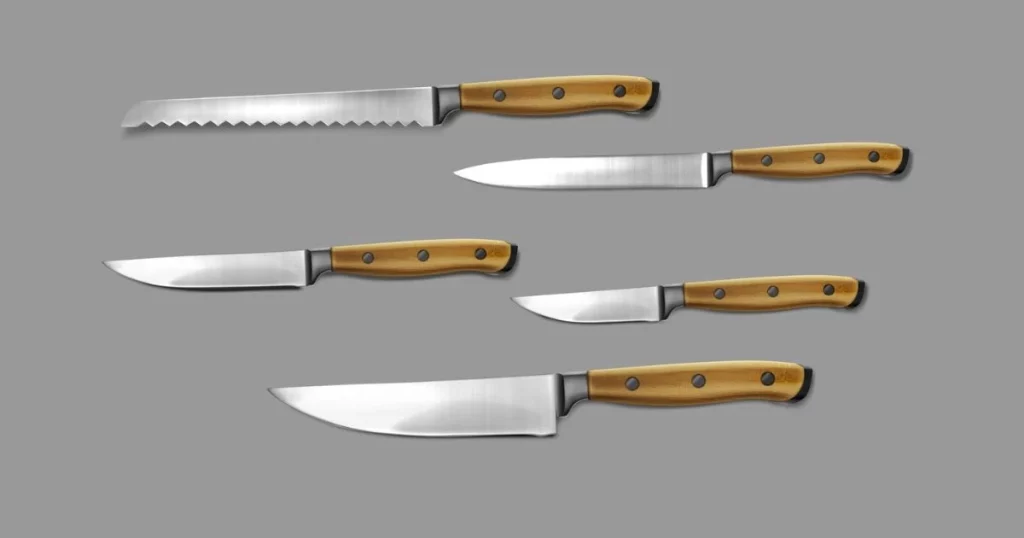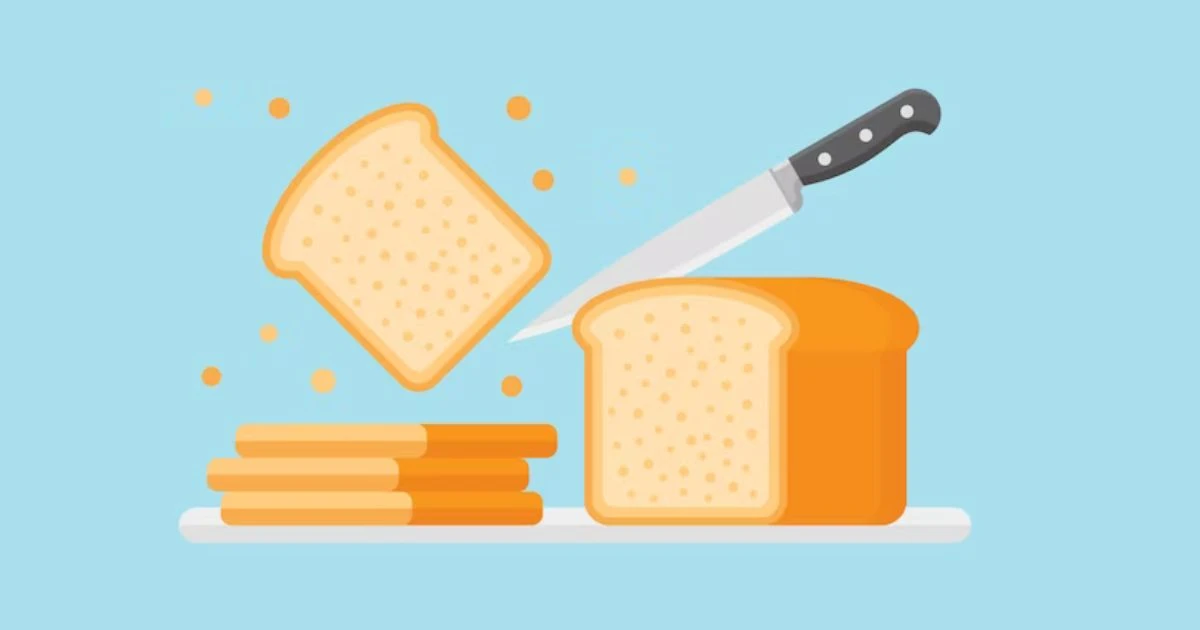No Bread Knife, No Problem: Alternative Bread Slicing Methods
Table of Contents
ToggleIntroduction
Slicing bread is a culinary skill that transcends the boundaries of novice and expert in the kitchen. The precision required to achieve uniform slices is often associated with the use of a dedicated bread knife. However, what if you find yourself without this specialized tool?
This guide will equip you with alternative techniques using common kitchen tools. Join us on a journey to discover the art and science of achieving perfect slices, showcasing that a lack of a bread knife should never stand between you and a satisfying loaf of freshly sliced bread.
The importance of proper bread slicing
Proper bread-slicing is not merely a culinary formality; it is an art that significantly impacts the overall dining experience. How bread is sliced affects its texture, flavour, and even the way it pairs with spreads, cheeses, or toppings.
Precision in slicing ensures that each piece maintains a consistent thickness, promoting a visually appealing presentation and facilitating even toasting. Beyond aesthetics, the technique employed can influence the structural integrity of the loaf, preventing it from collapsing or becoming overly compressed.
Moreover, when it comes to speciality bread like baguettes or artisanal loaves, the right slicing method can accentuate their unique textures and flavours. Ultimately, mastering the art of proper bread slicing enhances the enjoyment of every meal, turning a simple act into a culinary delight.
What are common tools for slicing bread?

Chef’s Knife:
- Explanation: A versatile, all-purpose knife with a broad blade and pointed tip.
- Use Ideal for slicing through a variety of bread types, especially softer ones. The sharp blade allows for precise cuts, but it may require a bit more finesse compared to a serrated knife.
Serrated Knife:
- Explanation: A knife with a serrated edge designed to grip and cut through crusty bread
- Use: Excellent for crusty or artisanal loaves, the serrated knife saws through the crust without crushing the softer interior. It provides a balance of control and effectiveness.
Electric Knife:
- Explanation: An electrical appliance with two oscillating blades designed for effortless slicing
- Use: Particularly handy when dealing with large quantities of bread or dense loaves. The electric knife minimizes effort and ensures consistent slices, making it a popular choice for events or gatherings.
How can we choose the right bread?
Selecting the right type of bread is a crucial first step in achieving optimal slices, regardless of the tool you use. Here’s a breakdown of considerations when choosing the right bread for slicing:
Freshness Matters:
- Explanation: Freshly baked bread tends to have a softer texture and a more delicate crumb structure.
- Considerations: Fresh bread is easier to slice, regardless of the tool. However, softer bread may benefit from a sharper knife to maintain clean cuts.
Consider Bread Shape:
- Explanation: The shape of the bread affects the slicing technique required.
- Considerations: Loaves (e.g., baguettes, ciabatta): Long loaves may be more manageable with a slicing motion, while round loaves may need a different approach.
Thickness Preference:
- Explanation: Personal preferences for slice thickness can impact the bread and slicing method choice.
- Considerations: Sandwich Slices: Uniform thickness is crucial for even toasting and a balanced sandwich.
Which are the essential tools for slicing bread without a bread knife?
When faced with the challenge of slicing bread without a dedicated bread knife, several essential tools can serve as effective alternatives. Here’s a closer look at these tools and how to use them to achieve perfect slices:
Serrated Knife:
Description: A knife with a serrated edge designed for cutting through crusty exteriors.
Usage: Ideal for crusty or artisanal bread, the serrated knife works best with a gentle sawing motion. The serrations grip the crust, allowing for clean slices without compressing the soft interior.
Electric Knife:
- Description: An electrically powered knife with oscillating blades for effortless slicing.
Usage: Perfect for handling large loaves or dense bread. Hold the electric knife steadily and guide it through the bread with minimal pressure. The electric knife’s powered motion ensures consistent slices.
Dental Floss:
- Description: A thin, flexible string of dental floss.
- Usage: Wrap dental floss around the loaf where you want to cut. Cross the ends and pull them in opposite directions, allowing the floss to cleanly slice through the bread. This method is excellent for soft and sticky breads.
Wire Cheese Slicer:
- Description: A tool designed for slicing cheese with a wire attached to a handle.
- Usage: Repurpose the wire cheese slicer for bread by placing it against the loaf and pulling it through with a steady hand. This method is effective for achieving even slices, especially with softer bread.
A step-by-step guide to using dental floss for bread slicing
- Slicing bread with dental floss might sound unconventional, but it’s a surprisingly effective method, especially for soft or sticky bread.
Step 1: Fold Your Resources
- Untaxed and unflavored floss is preferable to avoid any unwanted residue or taste transfer.
Step 2: Prepare the Bread
- Place the loaf on a stable cutting surface This firms up the texture, making it easier to cut.
Step 3: Measure and Cut the Floss
Pull out a length of dental floss that is longer than the width of the bread. This ensures you have enough floss to wrap around the entire loaf.
Step 4: Position the Floss
Hold each end of the dental floss and position it where you want to cut the bread. It’s crucial to have an idea of the desired thickness of each slice.
Step 5: Wrap the Floss Around the Bread
Gently wrap the dental floss around the bread at the predetermined cutting point. Cross the ends of the floss, creating a loop around the loaf.
Step 6: Pull the Floss Through
Holding the crossed ends firmly, pull the dental floss through the bread with a back-and-forth motion. The floss will cut through the loaf cleanly, giving you a precise slice.
Step 7: Repeat for Additional Slices
If you want more slices, repeat the process. Make sure to reposition the floss for each cut to maintain uniform thickness.
Step 8: Clean the Floss
Between slices, clean any accumulated bread crumbs from the dental floss to ensure smooth, residue-free cuts.
Using a wire cheese slicer for bread
Here’s a step-by-step guide on how to use a cable cheese slicer for bread:
Step 1: Select the Right Wire Cheese Slicer
- Ensure your wire cheese slicer is clean and in good condition. Opt for a model with a sturdy handle and a taut wire for optimal slicing.
Step 3: Position the Wire Slicer
- Hold the wire cheese slicer at a slight angle to the bread. The angle helps the wire grip the loaf better and prevents it from tearing or sticking to the bread.
Step 4: Place the Slicer Against the Bread
- Gently press the wire cheese slicer against the bread where you want to cut. The wire should be parallel to the cutting surface.
Step 5: Pull the Slicer Through
- With a smooth and steady motion, pull the wire cheese slicer through the bread. The sharpness of the wire will cleanly slice through the loaf, providing you with even slices.
Step 6: Adjust for Thickness
- If your wire cheese slicer has an adjustable thickness feature, you can modify it according to your preference. For thinner slices, tighten the wire; for thicker slices, loosen it.
Step 7: Clean the Wire
- Between slices, clean any residual crumbs from the wire to ensure it continues to cut smoothly.
Step 8: Repeat for Additional Slices
- Repeat the process for each slice you need, adjusting the position of the wire slicer as necessary.
Step 9: Serve and Enjoy
- Arrange your freshly sliced bread on a plate or in a basket. Your wire cheese slicer has now become a versatile tool for achieving neat and uniform slices.
Storing bread properly to maintain freshness
Room Temperature Storage:
For sliced bread:
Keep store-bought sliced bread in its original packaging or transfer it to a bread box. If using a bread box, make sure it has ventilation to prevent moisture buildup
Refrigeration:
- Avoid Refrigerating:
- Refrigeration can accelerate the staling process and change the texture of the bread.
- Exceptions include bread with perishable fillings like cream or custard.
Freezing:
For long-term storage:
Slice the bread before freezing for convenience.
Bread Box:
Use a Ventilated Bread Box:
A bread box with ventilation helps maintain the right level of humidity. Choose a box made of wood or a combination of materials for better air circulation.
Considerations:
- Avoid Exposure to Sunlight:
- Store bread away from direct sunlight to prevent the crust from becoming too hard.
Separate bread with fillings:
- If storing different types of bread in the same container, separate those with fillings to prevent flavours from mingling
Conclusion
In conclusion, mastering the art of bread slicing without a traditional bread knife opens up a world of possibilities, demonstrating the versatility of common kitchen tools and ingenious hacks.
Whether you choose for the care of a chef’s knife, the hold of a saw-like blade, the competence of an electric knife, the subtlety of dental floss, or the even parts attained with a wire cheese slicer, each technique transports its compensations to the table.
Thoughtful the features of different bread kinds, the position of correct method, and the meaning of selecting the right instrument for the job agrees you to raise your bread-slicing ready.
FAQS
Can I use an even cook’s knife to share bread?
- Absolutely! Ensure the knife is sharp and employ a sawing motion for best results, especially with softer bread varieties.
Is it possible to use an electric knife for slicing all types of bread?
- Yes, an electric knife is a versatile option for slicing various bread types, from soft loaves to crusty artisanal varieties. Its powered motion ensures a consistent cut, making it particularly useful for larger or denser loaves.
How does dental floss help in slicing bread, and is it suitable for all bread types?
- Dental floss is a surprisingly effective tool, especially for soft or sticky bread. By wrapping it around the loaf and pulling it through, you can achieve clean slices without squishing the bread. It’s particularly useful for delicate textures.
Can a wire cheese slicer be used for all bread varieties?
- While a wire cheese slicer is excellent for softer bread, it may not be the ideal choice for very crusty loaves. However, it offers a unique method for achieving even slices without the need for a traditional bread knife.
Are there specific considerations when using a serrated knife for bread slicing?
- Yes, a serrated knife is effective for crusty or artisanal bread. Ensure a gentle sawing motion to avoid crushing the softer interior. It’s a versatile choice but may not provide the precision needed for softer loaves compared to other methods




